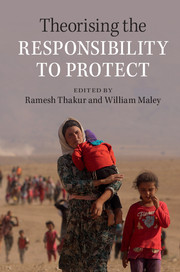Book contents
- Frontmatter
- Contents
- List of figures
- Notes on contributors
- Part I Context
- 1 Introduction: theorising global responsibilities
- 2 The evolution of the Responsibility to Protect: from concept and principle to actionable norm
- 3 From the right to persecute to the Responsibility to Protect: Feuerbachian inversions of rights and responsibilities in state–citizen relations
- 4 The Responsibility to Protect and a theory of norm circulation
- Part II The Responsibility to Protect, normative theory and global governance
- Part III The Responsibility to Protect and international social purposes
- Index
4 - The Responsibility to Protect and a theory of norm circulation
from Part I - Context
Published online by Cambridge University Press: 05 August 2015
- Frontmatter
- Contents
- List of figures
- Notes on contributors
- Part I Context
- 1 Introduction: theorising global responsibilities
- 2 The evolution of the Responsibility to Protect: from concept and principle to actionable norm
- 3 From the right to persecute to the Responsibility to Protect: Feuerbachian inversions of rights and responsibilities in state–citizen relations
- 4 The Responsibility to Protect and a theory of norm circulation
- Part II The Responsibility to Protect, normative theory and global governance
- Part III The Responsibility to Protect and international social purposes
- Index
Summary
In this chapter, I reflect on how the Responsibility to Protect (R2P) as an idea and norm relates to the ongoing theoretical debates about the origins and diffusion of norms in international relations literature. Among international relations theories, it is constructivism that pays the most attention to the role of ideas and norms. While realism regards ideas and norms as epiphenomena, and neoliberalism focuses on their instrumental and utilitarian value, or ideas as ‘hooks’, constructivism regards ideas as having a causal and constitutive effect. And constructivism has produced a rich literature not only on whether norms matter, but also how they matter. More recently, scholars have turned their attention to the processes and mechanisms of the spread of norms, focusing on issues of contestation and agency. Hence, new insights into the outcome of norm diffusion have emerged, which hold that new norms are seldom adopted wholesale, but are localised and translated to fit the context and need of the norm-takers. One of the key points of interest is that to understand how norms matter, one has to look into whose norms matter.
R2P poses a special challenge to these theoretical debates about agency in norm diffusion. Because of its close association with human rights and humanitarian intervention debates that long preceded it, R2P is often associated with Western political theory and agency. While some of the proponents of the norm vigorously deny that R2P reflects the traditional North–South fault line,1 that perception endures in the developing world. The Canadian hand behind the creation of the International Commission on Intervention and State Sovereignty (ICISS) and the explicit linking by its then Foreign Minister Lloyd Axworthy of R2P with other instruments of human security, such as the International Criminal Court and the Ottawa anti-personnel landmines treaty, has led to the identification R2P with a distinctive Western ‘freedom from fear’ agenda, at the expense of broader elements of human security (including but not limited to ‘freedom from want’).
The receptivity to a new international norm is likely to be higher if the responsibility for its creation and diffusion is seen to be more broadly shared than being credited to any particular group – whether the North or the South.
- Type
- Chapter
- Information
- Theorising the Responsibility to Protect , pp. 59 - 78Publisher: Cambridge University PressPrint publication year: 2015
- 11
- Cited by



